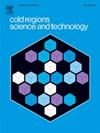Numerical simulation of water migration in saturated soft clay induced by horizontal freezing
IF 3.8
2区 工程技术
Q1 ENGINEERING, CIVIL
引用次数: 0
Abstract
The application of artificial freezing methods in soft clay foundations faces a series of complex issues, especially in horizontal freezing processes, where the thermo-hydro-mechanical coupling mechanisms of soft clay are not well understood, leading to difficulties in predicting and controlling the related freezing processes. Investigating the thermo-hydro-mechanical coupling mechanisms of soft clay under horizontal freezing conditions is crucial for enhancing the reliability and effectiveness of freezing treatment techniques in soft clay foundations. This study formulates thermo-hydro-mechanical coupling control equations for saturated soft clay under horizontal freezing, grounded in energy and mass conservation principles, and validates the model's accuracy through laboratory experiments. The findings indicate that the model effectively characterizes the interactions among water migration, temperature distribution, and stress field variations during horizontal freezing. The study reveals the driving effect of temperature potential energy and gravitational potential energy on water migration, with temperature-induced changes dominating the process. Additionally, temperature variations significantly affect key parameters such as pore- water pressure, freezing front progression, and unfrozen water content. The research provides theoretical support for predicting the freezing process of soft clay foundations in horizontal freezing engineering, offering guidance for optimizing freezing construction techniques.
水平冻结诱导饱和软黏土水运移的数值模拟
人工冻结方法在软粘土地基中的应用面临着一系列复杂的问题,特别是在水平冻结过程中,由于对软粘土热-水-力耦合机制的认识不清,导致相关冻结过程的预测和控制存在困难。研究水平冻结条件下软粘土的热-水-力耦合机理,对于提高软粘土地基冻结处理技术的可靠性和有效性至关重要。基于能量和质量守恒原理,建立了饱和软黏土水平冻结条件下的热-水-力耦合控制方程,并通过室内实验验证了模型的准确性。研究结果表明,该模型能有效表征水平冻结过程中水运移、温度分布和应力场变化之间的相互作用。研究揭示了温度势能和重力势能对水运移的驱动作用,温度变化主导了水运移过程。此外,温度变化显著影响孔隙水压力、冻结锋进程和未冻水含量等关键参数。研究结果为水平冻结工程中软土地基冻结过程的预测提供了理论支持,为优化冻结施工技术提供了指导。
本文章由计算机程序翻译,如有差异,请以英文原文为准。
求助全文
约1分钟内获得全文
求助全文
来源期刊

Cold Regions Science and Technology
工程技术-地球科学综合
CiteScore
7.40
自引率
12.20%
发文量
209
审稿时长
4.9 months
期刊介绍:
Cold Regions Science and Technology is an international journal dealing with the science and technical problems of cold environments in both the polar regions and more temperate locations. It includes fundamental aspects of cryospheric sciences which have applications for cold regions problems as well as engineering topics which relate to the cryosphere.
Emphasis is given to applied science with broad coverage of the physical and mechanical aspects of ice (including glaciers and sea ice), snow and snow avalanches, ice-water systems, ice-bonded soils and permafrost.
Relevant aspects of Earth science, materials science, offshore and river ice engineering are also of primary interest. These include icing of ships and structures as well as trafficability in cold environments. Technological advances for cold regions in research, development, and engineering practice are relevant to the journal. Theoretical papers must include a detailed discussion of the potential application of the theory to address cold regions problems. The journal serves a wide range of specialists, providing a medium for interdisciplinary communication and a convenient source of reference.
 求助内容:
求助内容: 应助结果提醒方式:
应助结果提醒方式:


